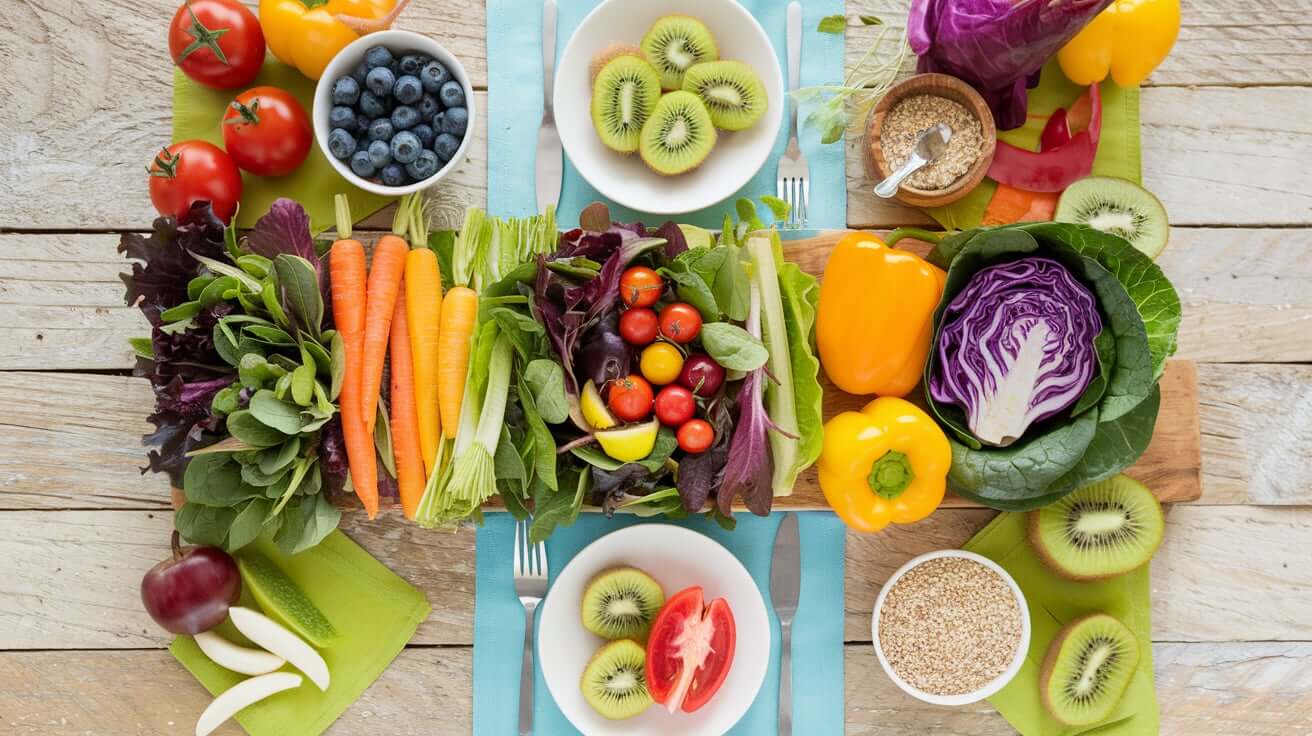The Ultimate Guide to the Rainbow Diet: Eating for Health and Vitality

Table of Contents
- Introduction
- What is the Rainbow Diet?
- The Science Behind Eating the Rainbow
- Color by Color: Benefits and Food Sources
- How to Implement the Rainbow Diet
- Rainbow Diet Meal Plan and Recipes
- Potential Health Benefits of the Rainbow Diet
- Challenges and How to Overcome Them
- Rainbow Diet vs. Other Popular Diets
- Frequently Asked Questions
- Conclusion
Introduction
In a world where fad diets come and go, the rainbow diet stands out for its simplicity, sustainability, and scientific backing. This approach to eating isn’t about restriction or counting calories; instead, it’s about embracing a wide variety of colorful, nutrient-dense foods to support overall health and wellbeing.
In this comprehensive guide, we’ll explore everything you need to know about the rainbow diet. From its fundamental principles to practical implementation tips, scientific benefits, and even some mouth-watering recipes, we’ve got you covered. Whether you’re looking to boost your health, increase your energy levels, or simply add more variety to your meals, the rainbow diet could be the colorful solution you’ve been seeking.
So, let’s dive in and discover how eating the rainbow can transform your health and your plate!
What is the Rainbow Diet?
The rainbow diet, also known as “eating the rainbow,” is not a diet in the traditional sense of restriction or specific meal plans. Instead, it’s a flexible, intuitive approach to eating that focuses on consuming a wide variety of colorful fruits and vegetables. The basic principle is simple: the more color you incorporate into your diet, the more diverse nutrients you consume.
Key principles of the rainbow diet include:
- Variety: Aim to eat fruits and vegetables of all colors regularly.
- Natural Colors: Focus on naturally colorful foods rather than artificially colored products.
- Whole Foods: Emphasize whole, minimally processed foods.
- Balance: While colorful plant foods are the stars, the diet can include other food groups for balance.
- Flexibility: There are no strict rules; the goal is to increase the variety of colors in your diet over time.
The rainbow diet is based on the idea that different colored fruits and vegetables contain different phytonutrients, each offering unique health benefits. By eating a variety of colors, you ensure that you’re getting a broad spectrum of these beneficial compounds.
This approach to eating aligns well with recommendations from major health organizations. For instance, the World Health Organization (WHO) and many national health agencies recommend consuming a variety of fruits and vegetables daily for optimal health.
The rainbow diet is not about eliminating food groups or adhering to strict guidelines. Instead, it’s about adding more color, variety, and nutrient-dense foods to your existing diet. This makes it a sustainable and enjoyable approach to healthy eating that can benefit people of all ages and dietary preferences.
The Science Behind Eating the Rainbow
The rainbow diet isn’t just visually appealing; it’s rooted in solid nutritional science. The colors of fruits and vegetables are not merely nature’s way of making food look attractive; they’re indicative of the different phytonutrients present in these foods.
Phytonutrients, also known as phytochemicals, are compounds produced by plants to protect themselves from environmental threats like insects, fungi, and UV radiation. When we consume these compounds, they provide various health benefits to our bodies.
Here’s a brief overview of the science behind eating the rainbow:
- Antioxidant Power: Many phytonutrients act as antioxidants in our bodies. Antioxidants help neutralize harmful free radicals, which can damage cells and contribute to chronic diseases and aging. Different colored foods contain different types of antioxidants, each with unique benefits.
- Anti-Inflammatory Effects: Chronic inflammation is linked to numerous health issues, including heart disease, diabetes, and certain cancers. Many phytonutrients have anti-inflammatory properties, helping to reduce inflammation in the body.
- Cellular Communication: Some phytonutrients can influence how cells communicate with each other, which can affect various bodily processes, including the immune response and cell regeneration.
- Gene Expression: Certain phytonutrients can influence gene expression, potentially reducing the risk of certain diseases by turning on protective genes or turning off harmful ones.
- Synergistic Effects: Research suggests that phytonutrients often work synergistically, meaning their combined effect is greater than the sum of their individual effects. This is one reason why eating a variety of colorful foods is more beneficial than relying on supplements.
- Microbiome Support: Many colorful plant foods are rich in fiber, which supports a healthy gut microbiome. A diverse microbiome is associated with numerous health benefits, including improved digestion, stronger immunity, and even better mental health.
- Nutrient Density: Colorful fruits and vegetables are typically nutrient-dense, meaning they provide a high amount of vitamins, minerals, and beneficial compounds relative to their calorie content.
Studies have shown that diets rich in a variety of fruits and vegetables are associated with numerous health benefits, including reduced risk of chronic diseases, improved cognitive function, and better overall health outcomes.
For example, a 2014 study published in the Journal of Epidemiology and Community Health found that eating seven or more portions of fruits and vegetables daily was associated with a 42% lower risk of death from all causes.
Another study, published in the International Journal of Epidemiology in 2017, found that increased fruit and vegetable intake was associated with lower rates of depression and improved mental wellbeing.
The science is clear: incorporating a rainbow of colors into your diet isn’t just about eating pretty food; it’s about providing your body with a diverse array of compounds that support optimal health and wellbeing.
Color by Color: Benefits and Food Sources
Let’s break down the rainbow diet color by color, exploring the unique benefits and food sources for each:
Red
Red fruits and vegetables are packed with powerful antioxidants like lycopene and anthocyanins.
Benefits:
- Heart health support
- Reduced risk of certain cancers, particularly prostate cancer
- Anti-inflammatory properties
- Improved skin health
Food Sources:
- Tomatoes
- Watermelon
- Red bell peppers
- Strawberries
- Raspberries
- Red apples
- Beets
- Red cabbage
Orange
Orange foods are rich in beta-carotene, which the body converts to vitamin A, and other carotenoids.
Benefits:
- Improved eye health and vision
- Strengthened immune system
- Enhanced skin health
- Reduced risk of heart disease
Food Sources:
- Carrots
- Sweet potatoes
- Pumpkin
- Oranges
- Apricots
- Mangoes
- Butternut squash
- Cantaloupe
Yellow
Yellow fruits and vegetables contain compounds like lutein and zeaxanthin, which are particularly beneficial for eye health.
Benefits:
- Enhanced eye health, particularly protection against age-related macular degeneration
- Improved cognitive function
- Reduced inflammation
- Support for a healthy heart
Food Sources:
- Corn
- Yellow bell peppers
- Bananas
- Pineapple
- Yellow squash
- Lemons
- Yellow watermelon
- Golden beets
Green
Green vegetables are nutritional powerhouses, rich in chlorophyll, folate, and various phytochemicals.
Benefits:
- Detoxification support
- Improved digestion
- Boosted immune function
- Heart health support
- Potential cancer-fighting properties
Food Sources:
- Spinach
- Kale
- Broccoli
- Brussels sprouts
- Green beans
- Asparagus
- Avocado
- Green apples
Blue/Purple
Blue and purple foods contain anthocyanins, powerful antioxidants that give these foods their distinctive color.
Benefits:
- Improved cognitive function and memory
- Reduced inflammation
- Heart health support
- Potential anti-aging properties
Food Sources:
- Blueberries
- Blackberries
- Eggplant
- Purple grapes
- Plums
- Purple cabbage
- Purple potatoes
- Acai berries
White/Brown
While not colorful, white and brown foods contain beneficial compounds like allicin and selenium.
Benefits:
- Immune system support
- Heart health promotion
- Potential cancer-fighting properties
- Improved bone health
Food Sources:
- Garlic
- Onions
- Cauliflower
- Mushrooms
- Parsnips
- Turnips
- Brown pears
- White beans
By incorporating foods from each of these color categories into your diet regularly, you ensure that you’re getting a wide variety of nutrients and beneficial compounds. Remember, the goal is not to eat every color at every meal, but to include a diverse range of colors in your diet over time.
How to Implement the Rainbow Diet
Implementing the rainbow diet doesn’t require a complete overhaul of your eating habits. Instead, it’s about gradually increasing the variety and amount of colorful fruits and vegetables in your diet. Here are some practical tips to help you eat the rainbow:
- Start with a Color Audit: Take a look at your current diet. Which colors are you eating regularly, and which are missing? This can help you identify areas for improvement.
- Set a Daily Color Goal: Aim to eat at least one food from each color category daily. As you get more comfortable, try to increase this to multiple foods from each category.
- Shop the Rainbow: When grocery shopping, challenge yourself to buy fruits and vegetables of every color. Farmer’s markets can be great places to find a variety of colorful, seasonal produce.
- Make Colorful Snacks: Keep cut-up vegetables and fruits of various colors in your fridge for easy snacking. Think carrot sticks, bell pepper slices, berries, etc.
- Add Color to Every Meal: Try to include at least two different colored fruits or vegetables in every meal.
- Experiment with New Foods: Each week, try a new colorful fruit or vegetable you’ve never had before. This keeps things interesting and expands your palate.
- Use Herbs and Spices: Many herbs and spices are packed with phytonutrients. Use them liberally to add both flavor and nutrition to your meals.
- Blend a Rainbow Smoothie: Smoothies are an easy way to combine multiple colors in one meal. Try blending fruits and vegetables of different colors for a nutrient-packed drink.
- Make Soups and Stews: These dishes are great for incorporating a variety of colorful vegetables.
- Don’t Forget About Frozen: Frozen fruits and vegetables are often just as nutritious as fresh and can help you include a variety of colors year-round.
- Create a Rainbow Salad: Challenge yourself to include as many colors as possible in your salads.
- Cook with Color in Mind: When planning meals, think about how you can incorporate more colors. Could you add some purple cabbage to your stir-fry? Some yellow bell peppers to your pasta sauce?
- Educate Yourself: Learn about the benefits of different colored foods. Understanding why they’re good for you can be motivating.
- Make it Fun for Kids: If you have children, turn eating the rainbow into a game. Create a chart where they can track the colors they eat each day.
- Be Flexible: Remember, the goal is progress, not perfection. If you can’t include every color every day, that’s okay. Focus on increasing variety over time.
Remember, the rainbow diet is about adding to your diet, not restricting. It’s a positive, inclusive approach to eating that can be adapted to fit various dietary preferences and needs. Whether you’re vegan, vegetarian, or an omnivore, there are colorful plant foods that can enhance your diet and your health.
Rainbow Diet Meal Plan and Recipes
To help you get started with the rainbow diet, here’s a sample one-day meal plan along with some simple, colorful recipes:
Sample One-Day Rainbow Diet Meal Plan
Breakfast: Rainbow Smoothie Bowl
- Blend: Spinach (green), banana (yellow), mixed berries (blue/purple/red), Greek yogurt (white)
- Top with: Sliced kiwi (green), orange segments (orange), chia seeds (brown)
Mid-Morning Snack: Crunchy Vegetable Sticks with Hummus
- Carrot sticks (orange)
- Red bell pepper slices (red)
- Cucumber slices (green)
- Served with homemade or store-bought hummus (brown/white)
Lunch: Rainbow Quinoa Salad
- Cooked quinoa (brown)
- Mixed salad greens (green)
- Cherry tomatoes (red)
- Yellow bell pepper (yellow)
- Purple cabbage (purple)
- Avocado (green)
- Grilled chicken or chickpeas (for protein)
- Lemon-olive oil dressing
Afternoon Snack: Fruit and Nut Mix
- Dried cranberries (red)
- Dried apricots (orange)
- Almonds (brown)
- Pistachios (green)
Dinner: Baked Salmon with Roasted Vegetables
- Baked salmon (pink)
- Roasted sweet potato (orange)
- Roasted Brussels sprouts (green)
- Roasted beetroot (red)
- Served with a side of brown rice (brown)
Dessert: Fresh Fruit Salad
- Strawberries (red)
- Mango (orange)
- Pineapple (yellow)
- Green grapes (green)
- Blueberries (blue)
Rainbow Diet Recipes
Here are three simple recipes to help you incorporate more color into your diet:
1. Rainbow Veggie Wrap
Ingredients:
- Whole grain wrap (brown)
- Hummus (white)
- Spinach leaves (green)
- Grated carrot (orange)
- Sliced red bell pepper (red)
- Sliced yellow bell pepper (yellow)
- Sliced purple cabbage (purple)
- Sliced avocado (green)
Instructions:
- Spread hummus on the wrap.
- Layer all vegetables on the wrap.
- Roll up tightly and slice in half.
2. Rainbow Stir-Fry
Ingredients:
- 1 tbsp olive oil
- 1 clove garlic, minced (white)
- 1 red bell pepper, sliced (red)
- 1 yellow squash, sliced (yellow)
- 1 cup broccoli florets (green)
- 1 cup purple cabbage, sliced (purple)
- 1 carrot, julienned (orange)
- 1 cup snap peas (green)
- 2 tbsp low-sodium soy sauce
- 1 tsp sesame oil
- Cooked brown rice or quinoa for serving (brown)
Instructions:
- Heat oil in a large pan or wok over medium-high heat.
- Add garlic and stir-fry for 30 seconds.
- Add all vegetables and stir-fry for 5-7 minutes until crisp-tender.
- Add soy sauce and sesame oil, toss to combine.
- Serve over brown rice or quinoa.
3. Rainbow Fruit Salad with Honey-Lime Dressing
Ingredients:
- 1 cup strawberries, halved (red)
- 1 cup pineapple chunks (yellow)
- 2 kiwis, peeled and sliced (green)
- 1 cup blueberries (blue)
- 1 orange, peeled and segmented (orange)
For the dressing:
- 2 tbsp honey
- 1 tbsp fresh lime juice
- 1 tsp lime zest
Instructions:
- In a large bowl, gently combine all the fruits.
- In a small bowl, whisk together honey, lime juice, and lime zest.
- Pour the dressing over the fruit and toss gently to coat.
- Chill for at least 30 minutes before serving to allow flavors to meld.
These recipes demonstrate how easy and delicious it can be to incorporate a variety of colors into your meals. Remember, the key is to experiment and find colorful combinations that you enjoy.
Potential Health Benefits of the Rainbow Diet
The rainbow diet, with its emphasis on a variety of colorful fruits and vegetables, offers numerous potential health benefits. Here’s an overview of some of the key advantages:
- Improved Heart Health: Many colorful fruits and vegetables are rich in antioxidants and fiber, which can help reduce the risk of heart disease. For instance, the lycopene in red tomatoes and watermelon has been linked to lower rates of heart disease.
- Better Digestive Health: The high fiber content in many colorful fruits and vegetables supports digestive health by promoting regular bowel movements and feeding beneficial gut bacteria.
- Enhanced Immune Function: Many phytonutrients have immune-boosting properties. For example, the vitamin C in citrus fruits and bell peppers, and the beta-carotene in orange vegetables like carrots and sweet potatoes, can help strengthen the immune system.
- Reduced Cancer Risk: Some studies suggest that a diet rich in fruits and vegetables may lower the risk of certain types of cancer. For instance, the sulforaphane in cruciferous vegetables like broccoli and Brussels sprouts has shown potential cancer-fighting properties.
- Improved Eye Health: Yellow and orange fruits and vegetables contain lutein and zeaxanthin, which are beneficial for eye health and may reduce the risk of age-related macular degeneration.
- Better Weight Management: Fruits and vegetables are generally low in calories but high in fiber and water content, which can help promote feelings of fullness and support healthy weight management.
- Enhanced Skin Health: Many colorful fruits and vegetables are rich in vitamins and antioxidants that support skin health. For example, the vitamin C in citrus fruits and berries supports collagen production, while the beta-carotene in orange vegetables can help protect skin from sun damage.
- Improved Cognitive Function: Some studies suggest that diets rich in colorful fruits and vegetables, particularly those high in antioxidants, may help slow cognitive decline and reduce the risk of neurodegenerative diseases.
- Better Blood Sugar Control: The fiber in fruits and vegetables can help slow the absorption of sugar into the bloodstream, potentially improving blood sugar control.
- Reduced Inflammation: Many phytonutrients have anti-inflammatory properties, which can help reduce chronic inflammation in the body. Chronic inflammation is linked to numerous health issues, including heart disease, diabetes, and certain cancers.
It’s important to note that while these potential benefits are promising, they come from eating a variety of whole fruits and vegetables as part of a balanced diet, not from supplements or isolated compounds. The synergistic effects of different nutrients working together in whole foods are likely responsible for many of these health benefits.
Challenges and How to Overcome Them
While the rainbow diet offers numerous benefits, implementing it can come with some challenges. Here are some common obstacles and strategies to overcome them:
- Challenge: Cost of Fresh Produce
- Solution: Buy seasonal produce, which is often cheaper. Consider frozen fruits and vegetables, which are nutritionally similar to fresh and often more affordable. Buy in bulk when items are on sale and freeze for later use.
- Challenge: Limited Availability of Certain Colors
- Solution: Use frozen or canned alternatives when fresh isn’t available. Remember that dried fruits count too. Experiment with new fruits and vegetables you might not have tried before.
- Challenge: Time for Preparation
- Solution: Prep vegetables in advance for quick use during the week. Use pre-cut vegetables when time is really tight. Incorporate raw vegetables that require no prep time.
- Challenge: Picky Eaters (especially children)
- Solution: Make eating colorful foods fun. Create games around trying new colors. Involve picky eaters in meal planning and preparation. Gradually introduce new foods alongside familiar ones.
- Challenge: Lack of Cooking Skills
- Solution: Start with simple recipes and gradually build your skills. Watch cooking videos online for techniques. Consider taking a cooking class focused on vegetable preparation.
- Challenge: Dining Out
- Solution: Look for restaurants with good vegetable options. Ask for extra vegetables as sides. Choose salads with a variety of colors. Remember that many cuisines, like Mediterranean and Asian, naturally incorporate a variety of colorful vegetables.
- Challenge: Boredom or Lack of Variety
- Solution: Experiment with new recipes regularly. Try preparing familiar vegetables in new ways (e.g., roasting instead of steaming). Explore international cuisines for new flavor combinations.
- Challenge: Storage and Spoilage
- Solution: Learn proper storage techniques for different fruits and vegetables. Plan meals to use more perishable items earlier in the week. Use sturdy vegetables (like carrots, cabbage) later in the week.
- Challenge: Balancing with Other Nutritional Needs
- Solution: Remember that the rainbow diet is about adding variety, not restriction. Incorporate colorful fruits and vegetables alongside other food groups for a balanced diet.
- Challenge: Overcoming Old Habits
- Solution: Make changes gradually. Start by adding one extra serving of colorful produce per day and build from there. Set realistic goals and celebrate small victories.
Remember, transitioning to any new way of eating takes time and patience. The key is to make gradual, sustainable changes that you can maintain long-term.
Rainbow Diet vs. Other Popular Diets
The rainbow diet differs from many popular diets in its focus on inclusion rather than restriction. Here’s how it compares to some other well-known dietary approaches:
- Rainbow Diet vs. Keto Diet
- Keto focuses on high fat, very low carb, which often limits fruit and some vegetable intake.
- Rainbow diet encourages all fruits and vegetables, regardless of their carbohydrate content.
- Rainbow Diet vs. Paleo Diet
- Paleo eliminates grains, legumes, and dairy, focusing on foods available to our ancestors.
- Rainbow diet has no specific food group restrictions, focusing instead on increasing variety of plant foods.
- Rainbow Diet vs. Mediterranean Diet
- These diets are quite compatible. The Mediterranean diet also emphasizes a variety of fruits and vegetables.
- Rainbow diet doesn’t specify amounts of other food groups (like whole grains, fish, olive oil) that are key in the Mediterranean diet.
- Rainbow Diet vs. Vegan Diet
- Vegan diets exclude all animal products.
- Rainbow diet is compatible with vegan eating but doesn’t require eliminating animal products.
- Rainbow Diet vs. Weight Watchers
- Weight Watchers focuses on portion control and assigns points to foods.
- Rainbow diet doesn’t involve calorie counting or point systems, instead emphasizing variety of colors.
- Rainbow Diet vs. DASH Diet
- DASH diet is designed to prevent and lower high blood pressure.
- Both diets emphasize fruits and vegetables, but DASH also specifies servings from other food groups and focuses on lowering sodium intake.
The rainbow diet’s flexibility allows it to be combined with many other dietary approaches. Its focus on increasing variety of plant foods can enhance most eating patterns.
Frequently Asked Questions
- Q: Is the rainbow diet suitable for weight loss?
A: While not specifically designed for weight loss, the high fiber content and nutrient density of colorful fruits and vegetables can support healthy weight management as part of a balanced diet. - Q: Can I follow the rainbow diet if I’m diabetic?
A: Yes, but it’s important to balance fruit intake and monitor carbohydrates. Consult with a healthcare provider or dietitian for personalized advice. - Q: Are there any risks associated with the rainbow diet?
A: For most people, increasing fruit and vegetable intake is safe and beneficial. However, those with certain health conditions (like kidney disease) may need to limit certain foods and should consult a healthcare provider. - Q: Do I need to eat every color every day?
A: While ideal, it’s not always practical. Aim for variety over the course of a week rather than stressing about daily perfection. - Q: Can I take supplements instead of eating all these fruits and vegetables?
A: Whole foods are always preferable to supplements. The synergistic effects of nutrients in whole foods are believed to be more beneficial than isolated nutrients in supplements. - Q: Is organic produce necessary for the rainbow diet?
A: While organic produce may have some benefits, the most important factor is increasing your overall intake of fruits and vegetables, whether organic or conventional. - Q: Can children follow the rainbow diet?
A: Yes, encouraging children to eat a variety of colorful fruits and vegetables is excellent for their health and helps establish good eating habits. - Q: How long does it take to see benefits from the rainbow diet?
A: Some people report feeling more energetic within days of increasing their fruit and vegetable intake. Long-term health benefits may take weeks or months to become noticeable. - Q: Can I drink fruit juices as part of the rainbow diet?
A: While fruit juices do contain nutrients, they’re often high in sugar and lack the fiber of whole fruits. It’s best to focus on whole fruits and vegetables. - Q: Is it possible to eat too many fruits and vegetables?
A: For most people, it’s difficult to eat too many fruits and vegetables. However, very high intakes of certain vegetables (like spinach) may interfere with nutrient absorption or medication effectiveness for some individuals. As always, moderation and variety are key.
Conclusion
The rainbow diet offers a refreshing approach to healthy eating that’s both scientifically sound and enjoyable to follow. By focusing on incorporating a variety of colorful fruits and vegetables into your diet, you can ensure that you’re getting a wide range of essential nutrients and beneficial phytochemicals.
Unlike many popular diets that focus on restriction, the rainbow diet is all about inclusion and variety. It’s flexible enough to fit into various dietary patterns and lifestyles, making it a sustainable approach to long-term health and wellness.
Remember, the goal isn’t perfection, but progress. Start by adding more colors to your plate gradually, and you’ll likely find that your meals become not only more nutritious but also more appealing and satisfying.
Whether you’re looking to improve your overall health, boost your immune system, enhance your skin’s glow, or simply add more variety to your meals, the rainbow diet offers a colorful path to better health. So why not start today? Your next meal is an opportunity to paint your plate with the vibrant colors of health and vitality.
Embrace the rainbow, and let your food be a delicious celebration of nature’s diversity and your commitment to health!




